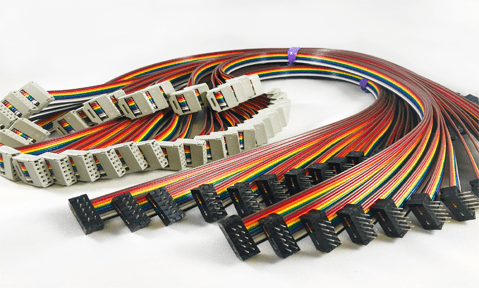A monitor serves as a crucial element of any computer system, functioning as the main point of interaction between the user and the device. Regardless of whether it is used for professional tasks, gaming, or leisure activities, the quality and characteristics of a monitor can greatly influence the overall user experience. This article explores the significance of monitors, the different types that exist, essential specifications, and guidance for choosing the most suitable option for your requirements.
1. What is a Monitor?

A monitor serves as a display apparatus that presents images produced by a computer’s graphics card. It enables users to visually engage with the computer’s operating system and various applications. Throughout the years, monitors have progressed from large CRT (cathode ray tube) designs to modern, streamlined, and energy-efficient LED and OLED screens.
a. Function of a Monitor
Interface: Exhibits the graphical user interface (GUI) of the operating system.
Productivity: Facilitates tasks such as browsing, designing, and coding with efficiency.
Entertainment: Acts as the display for video playback, gaming, and additional activities.
2. Types of Monitors
Monitors are available in a variety of types, each designed with unique features to serve different needs.
a. CRT Monitors
Cathode Ray Tube (CRT) monitors were the original form of computer displays and dominated the market throughout the 20th century. These substantial monitors utilized electron beams to excite phosphor dots on the screen, thereby producing images.
Advantages:
Minimal input lag, making them suitable for early gaming.
Disadvantages:
Cumbersome and large in size.
High power consumption.
b. LCD Monitors
Liquid Crystal Display (LCD) technology emerged as the standard in the early 2000s. These monitors employ a liquid crystal solution sandwiched between two glass panels to regulate light transmission.
Advantages:
Sleek design and lightweight.
Energy-efficient and straightforward to manufacture.
Disadvantages:
Older models have restricted viewing angles.
Not optimal for high-performance gaming or graphic design.
c. LED Monitors
Building upon LCD technology, Light Emitting Diode (LED) monitors utilize LED backlighting to enhance screen illumination. LED displays have become the most favored choice due to their efficiency and performance.
Advantages:
Outstanding brightness and contrast levels.
Energy-efficient and environmentally friendly.
Disadvantages:
Higher cost compared to traditional LCDs.
d. OLED Monitors
Organic Light Emitting Diode (OLED) monitors represent the forefront of display technology. They provide exceptional image quality, particularly in color accuracy and contrast.
Advantages:
True black levels and infinite contrast ratios.
Extremely thin and flexible designs.
Disadvantages:
Significant expense.
Risk of screen burn-in.
3. Key Specifications of Monitors
When selecting a monitor, several key specifications warrant consideration:
a. Screen Size
Monitors are available in a range of sizes, from compact 19-inch models to expansive 49-inch ultra-wide displays. A larger screen can enhance multitasking capabilities and improve media viewing experiences, though it may necessitate additional desk space.
b. Resolution
Resolution indicates the pixel count that a monitor can display. Common resolutions include:
– 1080p (Full HD): Suitable for most general applications.
– 1440p (QHD): Favored for gaming and professional tasks.
– 4K (Ultra HD): Ideal for video editing, design work, and immersive gaming experiences.
– 8K: Offers exceptional visual clarity, though it is not yet widely required.
c. Refresh Rate
The refresh rate, expressed in Hertz (Hz), denotes how many times per second a monitor updates its image. Higher refresh rates yield smoother visuals, particularly in gaming scenarios. Typical refresh rates include 60Hz, 120Hz, 144Hz, and even 240Hz for premium gaming setups.
d. Response Time
Response time measures the speed at which a pixel transitions from one color to another. Lower response times, generally quantified in milliseconds (ms), are advantageous for fast-paced gaming or video playback.
e. Panel Type
– TN (Twisted Nematic): Provides rapid response times but lacks in color accuracy and viewing angles.
– IPS (In-Plane Switching): Recognized for superior color accuracy and broader viewing angles, albeit with slower response times compared to TN panels.
– VA (Vertical Alignment): Strikes a balance between TN and IPS, offering commendable contrast and color reproduction.
4. Monitor Features to Look For
1. Curved versus Flat Monitors
Curved monitors offer a more immersive viewing experience, especially on larger displays. In contrast, flat monitors tend to be more advantageous for multitasking and in settings where multiple users need to view the screen simultaneously.
2. Aspect Ratio
The aspect ratio defines the proportional relationship between the width and height of the screen. Commonly encountered ratios include:
– 16:9: The standard widescreen format, ideal for a variety of applications.
– 21:9: Ultra-wide monitors, which are particularly beneficial for productivity tasks or gaming.
3. Ports and Connectivity
Contemporary monitors come equipped with various connectivity options, such as:
– HDMI: Widely used for both video and audio transmission.
– DisplayPort: Offers higher bandwidth, facilitating improved resolution and refresh rates.
– USB-C: Increasingly found in newer monitors, providing capabilities for power delivery and data transfer.
4. Adjustable Stands
Monitors featuring adjustable stands enhance ergonomic comfort. It is advisable to seek models that offer height adjustment, tilt, and swivel functionalities to promote comfort during prolonged usage.
5. Gaming Monitors vs. Professional Monitors
1. Gaming Monitors
Gaming monitors are engineered to enhance performance. Their essential characteristics encompass:
– Elevated refresh rates (144Hz or higher).
– Minimal response times (ranging from 1 to 5 milliseconds).
– Compatibility with G-Sync/FreeSync technology to prevent screen tearing.
2. Professional Monitors
Professional monitors focus on delivering precise color accuracy and high resolution, catering to the needs of creative professionals such as designers and video editors. These monitors typically feature factory calibration, support for extensive color gamuts, and superior resolutions (4K or above).
6. Ergonomics and Eye Care
1. Blue Light Reduction
Numerous monitors are now equipped with blue light reduction technology designed to alleviate eye strain during extended usage. Some models even feature “night modes” that modify the color temperature to lessen blue light exposure.
2. Flicker-Free Functionality
Flickering can lead to eye discomfort and fatigue, particularly during lengthy work or gaming sessions. Monitors that incorporate flicker-free technology utilize pulse width modulation (PWM) to diminish flicker, thereby enhancing user comfort.
3. Anti-Glare Finish
Monitors featuring anti-glare finishes are particularly advantageous in settings with significant ambient light. This characteristic minimizes reflections, enabling users to work comfortably without experiencing eye strain.
7. Future Trends in Monitors
1. Enhanced Resolutions and Refresh Rates
As technological advancements continue, monitors featuring 8K resolution and exceptionally high refresh rates are increasingly prevalent, particularly in gaming and professional settings.
2. Versatile and Foldable Screens
The advent of OLED technology has paved the way for the development of flexible and foldable monitors. Although these devices are still in the early stages of development, they hold the potential to revolutionize portability and ergonomic design in the future.
3. Quantum Dot Display Technology
Quantum Dot displays are gaining traction as a premium choice, offering superior color precision and brightness compared to conventional LED displays.
4. Energy Efficiency Initiatives
In response to rising environmental concerns, manufacturers are prioritizing the production of energy-efficient monitors. These devices consume less power and often carry eco-friendly certifications such as ENERGY STAR.
8. Conclusion
The monitor serves as an essential component of the computing experience, significantly affecting user interaction with their devices on a daily basis. Given the wide array of types, specifications, and features available, choosing the appropriate monitor is contingent upon individual requirements—be it for gaming, professional tasks, or general usage. By gaining insight into the fundamental features and emerging trends in monitor technology, users are empowered to make well-informed choices that enhance their overall computing experience.







